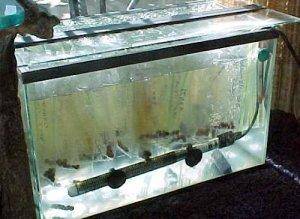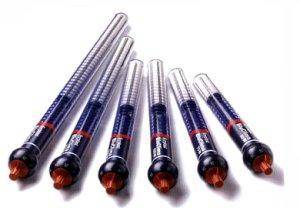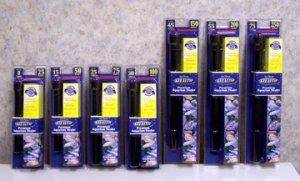A guide on using Fish Tank Heaters with FAQ, Forum and Online suppliers



Quick links - Answers
- How do I use aquarium heater
- How can I heat my fish tank
- How to install a fish tank heater
- How big aquarium heater do I need
- How to install a submersible aquarium heater
- How can I tell if my fish tank heater is working
- How deep should my aquarium heater go into the water
- What fish don't need a heater
- Heater overheated my tank, what should I do
- What is the wattage of a fish tank heater
- What if I buy a larger aquarium heater than I need
- What brand of heater is good for fish tank
- What fish can go into a room temperature tank
Brief Description
This page is an ultimate guide to fish tank heaters with pictures, FAQ, forum, and experiences of many fish keepers. It also points to websites that sell heaters online, simply follow this link to be forwarded to the list of online suppliers! We'd love to hear about your experiences with heaters, so before leaving this page post a comment at the bottom of this page, please! Also visit the following articles: Types of submersible aquarium heaters and instructions, Things to know about aquarium heaters - FAQ, Suppliers and Advantages of Titanium Aquarium Heaters.
Introduction
As this page is devoted to the purpose and usage of fish tank heaters, and as the market is full of various items, various information and sellers often aim at selling items without explaining all options that a fishkeeper can be given, perhaps the first task is to clarify whether an aquarium requires a heater - or whether it's completely OK to run your fish tank without one. It's a known fact that depending on the species you keep (fish) or grow (plants) one may encounter compatibility issues which we continue to discuss below, so let's start from beginning in order to clarify and cover every possible question.
Basic knowledge and principles
It is important to ensure that a heater is really required by your fish and plants by performing initial research, and more importantly make sure that warm water will be accepted by species kept in your tank. For this purpose you're welcome to search through records in our database: fish and plants.
It's because here at Aqua-Fish.Net we often hear from fishkeepers housing for example Pictus catfish and Goldfish in the same tank, however these species are incompatible in terms of temperature as Goldfish are actually coldwater fish. Therefore the first task is to understand demands of planned fish and plants! After you selected the right species, and once you have a tank that is large enough for all of them, only then you should go ahead and choose the right accessories including heater.
Sizing
Generally speaking larger aquariums need more powerful heaters. The smallest aquariums on the market need only some 25 watt heater, but a 300 liter (79.25 US gallons, 65.99 Imperial gallons) tank requires 300 watt or more powerful heaters instead. The size of a fish tank heater does matter and it is also important to understand following: Even a 50 watt heater can heat a 300 liter (79.25 US gallons, 65.99 Imperial gallons) aquarium to a certain level, but the speed how the desired temperature is achieved is very questionable.
Use a lid to minimise the heat losses
If a heater is required in an aquarium it is recommended to use a lid, not to leave it open-top, since only a little heat escapes from the surface to the room and the warming process is much faster. One of the most important factors is also the "starting temperature". If temperature in a room where's a fish tank placed at doesn't go under 24°C (75°F), then the required wattage is definitely lower than in a room with lowest temperature 18°C (64°F).
Integrated filters and heaters
Some heaters may be integrated within filters, however to a fishkeeper this is not considered to be the best practises as each accessory should be reachable in seconds. Additionally, sometimes you need to turn off the filter (when fish have built a nest or laid eggs - this is the case when a sponge filter has to be preferred), but heater must be turned on all the time. When you're upgrading from a small or old filter to a new one, you will also have to change the heater. Naturally, some exceptions may exist.
Heaters are especially needed during cold seasons
Tank heaters are needed especially during winter and other cold months when temperature in a room is lower than 20°C (68°F). On the other hand usually all fish species should survive temperature of about 20°C (68°F) because of a simple reason; water temperature in the wild usually varies from 18°C (64.40°F) up to 30°C (86.00°F) in 1 day! Bear in mind, that any creek or river is colder at night and the temperature raises as the sun moves up in the sky. Of course rooms usually offer stable conditions and very low temperature is very rare, however keeping temperature at low levels for a long period is not recommended.
High temperatures trigger spawning
One of the situations when a heater is needed is to trigger the spawning process in fish. Generally, most of tropical freshwater fish species will breed at about 27°C (80.60°F). Don't be tempted just to increase the temperature to support the courtship behaviour as there are more important factors which determine whether any fish are going to breed or not. These include stable chemistry, water current and pressure (this is related to simulating rainy seasons). Almost all tropical freshwater fish can breed successfully at 25°C (77.00°F) too.
Wattage
Wattage describes how many watts a heater consumes. If you purchased a 100W heater, then energy consumption is 0.1kW/hour. Determining wattage is crucial as it affects the process of heating and time that is required to heat a fish tank. As usual, the best is to give an example:
I was using one 50 watt heater in my 81 litre (21.40 US gallon, 17.82 Imperial gallon) tank in the past. Naturally, a 100 watt heater would be much more efficient however it was possible to reach 28°C or 29°C (approximately 82°F - 84°F) in a timely manner. The rule is to have 1 watt per 1 litre (3.78 Watt per 1 US gallon, 0.83 Imperial gallon) or a ratio that is very similar to the mentioned one. Thus, a tank that holds 200 litres (52.83 US gallons, 43.99 Imperial gallons) should be equipped with a 200W heater.
Placement
Don’t forget to place your heater in the place with good and continuous water flow. This is usually somewhere nearby the filter and this place shouldn’t be overgrown with high or medium-sized plants. Also, the heater should be fully submersible and waterproof too. Spend more money on buying quality heater, so you won't wake up and find all of your fish dead because the heater immersed itself.
Just for make things clear, always use thermometer. You can also plug your heater into a timer, so it will create similar conditions like in the wild.
Important facts
Your heater must be placed in the aquarium! The size matters, and thus never put any big heater into a fish tank that's too small! Rather spend some time searching for a small heater instead of using a way too big one! It doesn't look nice and it will waste a lot of space. A fully submersible heater can be placed diagonally of course.
When you have a chance to choose from 2 or more aquarium heaters that are for sale, always compare their wattage, sizes, and warranty. If some heater generates 50W, it doesn't mean that it requires 50W per hour! Output is always lower than power consumption!
Here we provide some pictures of heaters. You can also find an example picture of how-to install a heating equipment into the fish tank here.
A heater in an aquarium
Sera heaters
Ferplast heaters
Stealth heaters
Image sources: victoria-adventure.org, aquariumsystems.com, practicalfishkeeping.co.uk.
Usual questions and answers
We do collect common questions from our visitors which is why the frequent ones have been answered below.
"How do I use aquarium heater?" and "How can I heat my fish tank?"
Usage is simple, heaters usually come with rubber suckers. You put the heater into the aquarium, attach it to the suckers that are attached to glass. Plug in to the electricity and it works! The second question and answer on it; Aquarium heater is just one of the options. Another is heating the room where you have aquarium or aquariums. If operating costs to heat your room are lower than electricity costs when using a heater, then it's better to heat the room. It could sound weird, but if you have a fish house with, say, 5 or more fish tanks in just one room, then it's worth a consideration at least. Leaving sunlight to enter the room via windows is another useful technique.
How to install a fish tank heater?
It is necessary to follow all instructions given by the seller or given by enclosed guidelines that can be found in the heater package. Basically, if your fish tank heater is fully submersible, then you're allowed to place it anyhow, but bear in mind that the water flow must reach the heater in order to distribute the heat. If your heater comes with thermostat, then make sure that you can easily modify desired temperature.
How big aquarium heater do I need?
Usual mistake of new buyers is that the size means power. In general bigger heaters produce more heat, but it's not a must. Always check for wattage when asking. Even a small 200 watt heater can be more effective than larger that generates less heat.
How can I tell if my fish tank heater is working?
There is a small LED red control light on many heaters that simply says if a heater produces heat or not. When the control light is turned on, it means the heater does produce heat. If it's not turned on, the heater doesn't heat (assume that your heater has a thermostat). If the water is too cold and if desired temperature that's configured on the heater is higher, and if the heater doesn't heat, it means it's not working. Just to be 100% sure try the mentioned test with bucket described in the next paragraph.
You should also use a standalone aquarium thermometer along with a heater. Thermometers are cost effective solutions that usually don't need any maintenance and give precise answer on question if your fish tank heater works or not. If you're not sure, simply take the heater out of the aquarium, put it into a bucket with cold water and let it heat the water to 30°C (86.00°F) for instance. Check the water after an hour or less depending on wattage of the heater. Also ensure that there is some flow in the bucket.
How deep should my aquarium heater go into the water?
If the heater is fully submersible, then depth doesn't matter. In most cases it can be placed horizontally as well as vertically or in any other direction. If the heater is not fully submersible, then you can find a red line (or black, the colour may differ) on the heater - this indicates the maximum immersion. Also there should be another line informing about minimum immersion.
What fish don't need a heater
It's necessary to understand that if you're able to offer your fish a temperature of 22°C (71.60°F) each day a year without any heater, then most likely you won't need a heater at all. In some cases heaters are beneficial; when curing diseases for example. You could have been told that many tropical species require a temperature of 25 (77.00°F) or 26°C (78.80°F) at least, but one must understand that temperature in nature changes during the day. It's not unusual that during nights, temperatures of water in lakes or rivers are lower by 5 - 10°C in comparison to noons or afternoons. However, we can 100% say that coldwater species don't need a heater at all! Naturally, they need chiller instead.
What fish can go into a room temperature tank?
All tropical freshwater fish as long as the temperature varies between 20°C (68.00°F) and 30°C (86.00°F) during the year.
Heater overheated my tank, what should I do?
Once you noticed that the water is too hot, do a partial water change. If you don't have any chlorine remover, then don't hesitate to use tap water as high temperature may be a worse danger than chlorine. Firstly change 10% of water, this depends on capacity of the aquarium. If it's small, a small water change will help. If the tank is big, then it will be necessary to perform more partial water changes. If there is a lid on your aquarium, remove it until temperature becomes stable and lower.
What is the wattage of a fish tank heater?
Wattage means input. In general we can say that the higher input, the higher output. A 200 watt heater will heat a 100 litres (26.42 US gallons, 22.00 Imperial gallons) aquarium much faster than a 50 watt heater. Use our calculator, enter your fish tank's dimensions and see what's recommended wattage for your aquarium.
What if I buy a larger aquarium heater than I need?
While buying all accessories people may not be sure, or simply the shop assistant convinced buyers to buy bigger, better, more powerful one. The answer is as simple as possible; It's not a problem. As long as your aquarium can be heated properly, the size or wattage don't matter.
What brand of heater is good for fish tank?
We do recommend heaters by Sicce. However it's not the only brand and you should consider any brand you may find as long as it includes a thermostat. Price usually depends on wattage (higher wattage = higher price), but in general we can say that good heaters start at $40.
Additional questions and answers about heaters
On March 17th 2011 this page has been updated with the following content; Questions and answers from aqua-fish.net/answers have been merged with this article. Some of the questions below may be answered already on this page, however it's easy to find "your question" below; Instead of searching for answer within the article and comments that can be found below sponsored links. You're welcome to ask your questions if they haven't been answered on this page yet! Simply use the form that can be found at the bottom of this page.
-
Which heater is recommended for my fish tank?
Answer: This completely depends on how big is your aquarium. Let's mention a few examples:
- Dimensions are 52 x 55 x 100 (cm; height x width x length which equals to 20.47 x 21.65 x 39.37 inch), then you need heaters which give output of 353W.
- Dimensions are 40 x 40 x 60 (cm; height x width x length which equals to 15.75 x 15.75 x 23.62 inch), then you need heaters which give output of 118W.
You can calculate these numbers easily with our calculator.
-
What heater should I use for a 75 gallon (283.91 litres, 62.45 Imperial gallons) aquarium?
Answer: You can use one or more heaters, their total wattage should be approximately 350W. Naturally, if the room temperature is 24°C (75.20°F) during the year, then you can use low wattage heaters too.
-
Why is my goldfish aquarium warm?
Answer: Goldfish do not require heaters in the aquarium, if there is one there remove it. The only other reason is that the aquarium is absorbing heat from the external room temperatures.
-
What types of fish don’t need heaters?
Answer: Coldwater fish such as koi and goldfish do not require the use of a heater unless temperatures drop below 52°F (11 °C).
-
How can I tell if my heater is working?
Answer: Most aquarium heaters are now fitted with a led light that tells you when they are on or off. A good thermometer will tell you if the correct temp is being kept by the heater, If the temp rises too high then the thermostat may be broken, likewise if the temp starts to drop over a period of time the chances are that the heater has failed.
-
What should my thermostat be set at?
Answer: Most fish like their own temperature range and therefore should be kept only with others that both will live peacefully together and can tolerate the same water conditions. The store that you purchased your fish from will be able to give you the temperature to keep your fish at or you can research your fish online or at your local library. Some hobbyist raise the temperature of their aquarium by a degree or two in an effort to treat a parasite infection that depends on water temperature for its life cycle; most commonly ick.Feel free to browse our fish database (see fish images and profiles at the left side of this page) to find what temperature is preferred by your fish.
Suppliers of aquarium heaters
If any of the links within the below-shown list doesn't work, report it, please - at the bottom of this page.


